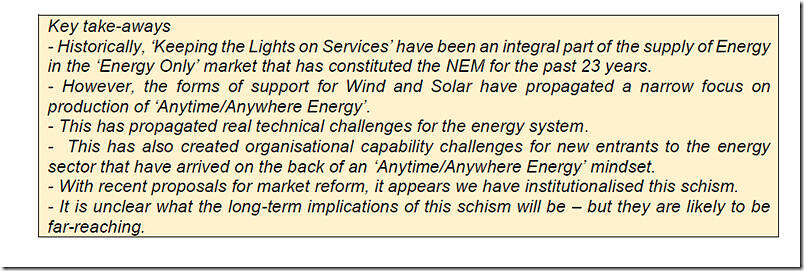This is a belated and back-dated article:
- set for 15th December 2021, which was the day we released GenInsights21
- from which we’ve extracted the full text of Key Observation 2/22 (minus footnotes), as follows:
In Theme 2 within Part 2 of the GRC2018, we wrote how ‘the NEM is developing an ‘us and them’ schism’ – with two commodities implicitly evolving (perhaps even diverging) within the NEM’s ‘energy only’ market structure, yet not explicitly supported in the central market rules:
- We spoke about ‘Anytime/Anywhere Energy’ by virtue of the form of support for wind and solar generation (in that the support is provided, regardless of the time or the place that this green energy is being supported – and no reference to the spatial or temporal requirements of the consumer);
- Leaving the declining residual volume of energy supplied by other generation types to supply a collection of ‘Keeping the Lights on Services’.
2.1 Implications for the industry
An example of this seemingly permanent rupturing was in the approach taken by the Energy Security Board in the form of their Final Advice to the Energy Ministers.
This Final Advice seemed heavily premised on an implicit assumption that there needs to be new markets created or new forms of support created, to ensure continued (but separate) supply of the ‘Keeping the Lights on Service’ that will become increasingly lacking in future years given the carving out of ‘Anytime/Anywhere Energy’ as a separately incentivised service.
Coupled with other initiatives:
- The market has proposals for Incentives for Firmness over various forward timescales:
- in some form of capacity mechanism, such as the proposed Physical Retailer Reliability Obligation (PRRO). With respect to these capacity mechanisms, the ‘Forecast Convergence’ analysis in Appendix 16 does raise questions about:
- what would or could be purchased, some period in advance of dispatch; and
- how much of it would actually be required.
- in some form of capacity mechanism, such as the proposed Physical Retailer Reliability Obligation (PRRO). With respect to these capacity mechanisms, the ‘Forecast Convergence’ analysis in Appendix 16 does raise questions about:
- The market has proposals for added incentives for services like inertia (see Appendix 11) and system strength – perhaps via Unit Commitment for Security.
- Attempts for explicit government support for various forms of firming in the market:
- Federal Government owned generator, Snowy Hydro, is proceeding with ‘Snowy 2.0’ and the Kurri Kurri GT:
- with many wondering if these projects would not have proceeded without government support.
- Capacity Factors (Appendix 21) of gas fired generation in recent years do show outstanding results for such a large investment.
- Announcements about the Federal UNGI (Underwriting New Generation Investment) scheme, but we have yet not seen any outcome of this.
- Federal Government owned generator, Snowy Hydro, is proceeding with ‘Snowy 2.0’ and the Kurri Kurri GT:
- Introduction of a bespoke mechanism to create Negawatts as an explicit mechanism (which is hopefully a short-term measure, prior to transition to a more sustainable and scalable two-sided market)
- Separate incentives being discussed (or explicit government funding provided) to incentivise the uptake of Storage at residential and industrial scale, ostensibly to redress the disproportionately weighted ‘Anytime/Anywhere’ nature of the energy supply arrangements incentivised by other means.
2.2 Organisational capability
The currently mandatory nature of Primary Frequency Response (PFR) is one driver for what could achieve more Wind Farms and Solar Farms supplying this service.
However, the optional commercial engagement of Wind and Solar Farms into the FCAS market has been much more modest:
- The 3 x Hornsdale Wind Farm units have been the only units supplying FCAS services in the NEM for several years, and this initiative required ARENA support to initiate.
- A second project (Woolnorth Wind Farm) has recently been registered to supply FCAS and again with ARENA support to achieve this milestone.
This same topic has been the subject of discussion internationally.
Much hope has been held that the addition of battery technology, co-located and integrated with either Wind or Solar, would assist in the process of ensuring that wind and solar technology can be neatly coupled with storage.
To operate successfully in this manner, the integrated site would need to operate as an integrated hybrid facility – and it is our understanding that AEMO would be welcome to registering projects that could demonstrate an ability to operate in a scheduled manner.
- Alas, as of November 2021, there are no true hybrid generators in the NEM.
- The AEMC published a final determination on this subject in December 2021 and is specific in its requirements.
However, we wonder if the schism in organisational capability created by the mechanisms of financial support have made it more difficult for potential project developers to recognise what is required in the electrical and operational sense – to make hybrid projects work in the ‘real world’.
The perceived reluctance to move toward the Scheduled category, with a possible commensurate increase in responsibility for the Wind and/or Solar proponents compared to Semi-Scheduled, now appears to be a real technical barrier to integrating a site (but for some this is seen as ‘Red Tape’ and ‘Just too hard’ to work through to resolve).




Leave a comment